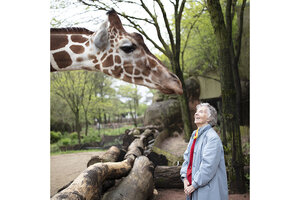You know Goodall and Fossey. Meet Dagg, ‘The Woman Who Loves Giraffes.’

Canadian biologist Anne Innis Dagg, co-author of the 1976 book “The Giraffe: Its Biology, Behavior, and Ecology,” visits the Brookfield Zoo in Illinois.
Courtesy of Zeitgeist Films
When Canadian biologist Anne Innis Dagg was 3 years old, her mother took her to the zoo for the first time. There she saw her first giraffe, and a lifelong love affair ensued. And who can blame her? Is there any other four-legged creature whose looks are more magisterially goofy?
Dagg is the focus of Alison Reid’s “The Woman Who Loves Giraffes,” and it confirms a long-held tenet of mine: If the subject of a documentary is fascinating, it doesn’t much matter if the filmmaking is workmanlike. Now in her 80s, Dagg is such a singular personality that everything about her seems sprightly and newly minted.
At 23, in the summer of 1956, with a master’s degree in biology, she traveled alone to South Africa during a time of mounting political unrest in order to study up close her beloved giraffes. Other than a Scottish study of red deer, she was the first person to venture into the wilds to investigate animal behavior.
Why We Wrote This
Documentaries often uncover issues and characters otherwise unknown. Monitor critic Peter Rainer says of this film’s subject, “Dagg is such a singular personality that everything about her seems sprightly and newly minted.”
This was years before either Jane Goodall or Dian Fossey embarked on their work with chimpanzees and mountain gorillas. Her dogged independence had a rich pedigree: Her mother, Mary Quayle, was the dean of women at the University of Toronto’s University College; her father, Harold Innis, was a famous economist.
Thanks to the welcoming ministrations of Alexander Matthew, whose citrus and cattle ranch was also home to many free-roaming giraffes, Dagg was able to closely observe these magnificent animals. Her research was groundbreaking, and the 16 millimeter color footage she shot at the time, amply displayed in the documentary, is breathtaking. (I was especially grateful that Dagg didn’t photograph any maulings or attacks – an unfortunate ingredient in far too many wildlife documentaries.)
By all rights, Dagg’s yearlong South African trip should have set the stage for a glorious scientific career. But in the 1960s and ’70s, after returning home, she found herself effectively closed out of academia, denied tenure at several leading universities despite the fact that she had acquired a Ph.D. and been published in prominent scientific journals. Women professors, especially in the sciences, were not welcomed. That she was also married was used as a further argument against her receiving tenure.
Between 1972 and 1979, she presented her discrimination case before the Ontario Human Rights Commission. She lost the fight but it was also at this time, in 1976, that she co-wrote (with Bristol Foster) what became the bible in her field: “The Giraffe: Its Biology, Behavior and Ecology.” But with no full-time academic position in sight, and no research money to return to Africa, her giraffe studies were curtailed.
She continued to write books and articles, many of a feminist bent, but it was only in 2010, when Amy Phelps, curator of the San Francisco Zoo, sought her out that she received her long-delayed due.
The most powerful moments in the movie come when we see Dagg, accompanied by her daughter Mary, return to Africa for the first time since 1956. She crosses some of the same terrain as she did in her 20s, and notes with awe that she could well be looking at the progeny of those she observed more than 50 years earlier.
But she’s no nostalgia junkie. The decimation of the giraffe population in the intervening decades – a drop of almost 40% since the 1980s alone – captures her full attention, and she has become a leading light in the giraffe conservation movement.
Why didn’t Dagg receive the same recognition in her prime as Goodall or Fossey? Dagg’s theory is that giraffes, as opposed to chimps or gorillas, are so different from us that they don’t inspire the same kind of global attention. They’re like unicorns, she says. But who can doubt the wonder they inspire in Dagg? Reunited with the African giraffes, her eyes look as rapt now as they must have been when she was that 3-year-old girl at the zoo.

